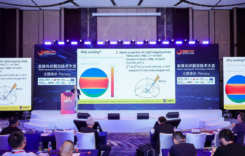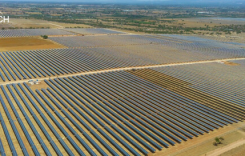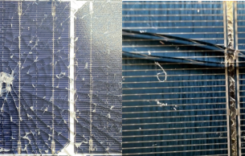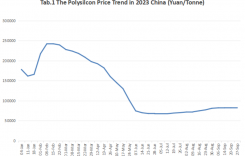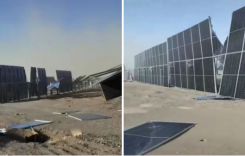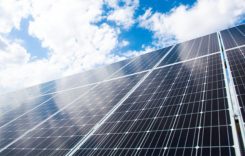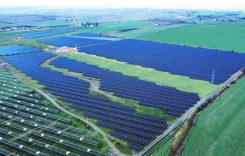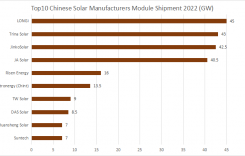PVTIME – South Africa’s renewable energy landscape has reached a pivotal moment with the successful commissioning of the PV2 section of the 240MW Moyi Photovoltaic Power Station. As the country’s largest single-unit solar facility, this project, which was delivered by a joint venture between China Energy Engineering International Group and Gezhouba Group, has now completed installation and testing and is energised. This marks a concrete step towards full commercial operation. For a nation grappling with energy security issues exacerbated by years of underperforming coal plants and rolling blackouts known locally as ‘load shedding’, as well as a legal commitment to reducing carbon emissions by 42% by 2030, this milestone has significant implications. It signals progress in bridging the long-standing divide between ambition and execution in Africa’s renewable energy sector, which has historically slowed the continent’s transition away from fossil fuels.
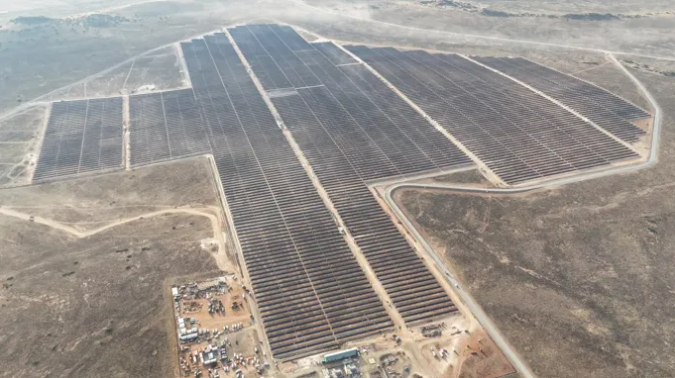
To understand the importance of the Moyi plant, it is helpful to consider it in the context of South Africa’s decade-long journey towards renewable energy, particularly by comparing it to earlier milestones such as the Jasper Solar Project. Commissioned in 2014, Jasper was once Africa’s largest PV plant with a capacity of 96MW. It was developed by a consortium including SolarReserve and Google. At the time, Jasper represented a breakthrough, demonstrating that large-scale solar power could flourish in South Africa’s sunny climate and paving the way for the country’s Renewable Energy Independent Power Producer Procurement Programme (REIPPPP). However, the Moyi plant represents a clear evolution in three key ways. Firstly, with a capacity of 240MW, it is more than twice the size of Jasper, reflecting South Africa’s growing demand for utility-scale renewables to offset the decline of coal. Secondly, Jasper relied heavily on European and American expertise, whereas the Sino-South African joint venture model behind Moyi integrates local delivery with Chinese engineering expertise on a large scale. This shift aligns with South Africa’s desire to build domestic capacity while accessing global capital and technology. Thirdly, whereas Jasper focused narrowly on power generation, Moyi is designed to align with South Africa’s updated Integrated Resource Plan (IRP) 2019, which prioritises projects that support both decarbonisation and energy security. The IRP aims to achieve 17.5GW of solar capacity by 2030, and Moyi alone will contribute almost 1.4% of this target, which is a modest yet significant proportion that highlights its potential to stimulate larger-scale deployment.
This evolutionary leap is all the more notable given South Africa’s historical challenges with infrastructure development. For years, the country’s energy sector has been hindered by capacity constraints at Eskom, the state-owned utility company, and by bureaucratic delays in approving new projects. The joint venture structure behind Moyi addresses these issues by combining China Energy Engineering’s proven ability to deliver large projects on time, as demonstrated by its work on Pakistan’s Quaid-e-Azam Solar Park, with the local knowledge of partners who understand South Africa’s regulatory landscape. This hybrid model is becoming increasingly common in global renewable projects, and its success in Moyi offers a template for future initiatives. In contrast to earlier projects that struggled to navigate local compliance, the Moyi team engaged with regional authorities from the outset to ensure that permits were secured without the protracted delays that derailed 14 REIPPPP projects between 2018 and 2022.
The project’s journey to energising PV2 has been defined by adaptability in the face of substantial challenges, many of which were similar to those faced by Jasper, but were overcome more quickly. Since breaking ground in March 2024, the team has advanced three parallel sections (PV1, PV2 and PV3) while overcoming a trifecta of hurdles: complex local approval processes involving multiple tiers of government; divergent technical standards differing from international norms, such as the specific durability requirements for solar panels in South Africa’s arid, high-UV environment; and harsh environmental conditions, including frequent dust storms in the Northern Cape region and challenging rocky terrain that complicated foundation work. Compounding these issues was the project’s sheer size, requiring over 600,000 solar panels, and the tight deadlines set by the client, who was targeting partial energisation within 18 months of starting work. Such factors often derail large-scale renewable projects in emerging markets: a 2023 report by the International Energy Agency found that 40% of African PV projects face delays of six months or more due to similar challenges.
The Moyi team’s response provides an excellent example of pragmatic project management, building on lessons learned from Jasper’s initial challenges. For example, Jasper faced delays when local communities raised concerns about land use. Moyi preempted this issue by conducting six months of community consultations before breaking ground. Rather than relying solely on international staff, the Moyi team also deployed skilled personnel with experience in African markets and invested in training local workers to operate specialised equipment, something Jasper did only minimally. Most notably, the team implemented a granular, dynamically adjustable construction plan that assigned daily tasks and clear accountability to individual teams. For instance, when a dust storm in June 2024 delayed the installation of panels in PV1, the team reallocated workers to wiring and testing in PV2, thereby ensuring that overall progress remained on track. This approach not only kept the project on schedule, but also demonstrated how international developers can adapt global best practices to local circumstances, a skill that is becoming increasingly important as investment in renewable energy shifts to regions with diverse regulatory and environmental landscapes.
Beyond its technical and logistical achievements, Moyi’s contribution to local job creation is a crucial aspect that requires thorough analysis, especially given that unemployment in South Africa hovers around 32%. During construction, the project employed over 1,200 people, 85% of whom were from the Northern Cape region, home to the Moyi plant. This is in contrast to Jasper, which employed 800 workers during construction, only 60% of whom were local. Moyi’s local hiring strategy was intentional: the team partnered with regional technical colleges to deliver 12-week training programmes in solar panel installation and electrical maintenance. These programmes equipped workers with transferable skills for future renewable projects. Of the 1,200 construction workers, 150 were retained for long-term operations and maintenance roles, which is a significant difference compared to Jasper, where only 50 local workers were retained post-construction.
The economic ripple effects extend beyond direct employment. For example, the project sourced 30% of its materials from local suppliers, including steel for panel racks from a Port Elizabeth factory and cabling from a Johannesburg-based firm. According to a preliminary analysis by the Northern Cape Economic Development Agency, this local procurement supported an additional 200 jobs in the supply chain. In contrast, Jasper only sourced 15% of materials locally, reflecting a shift in industry practices towards greater localisation. This is significant because South Africa’s National Development Plan 2030 emphasises ‘inclusive growth’ through renewable energy. The plan argues that job creation in this sector could help to reduce poverty in rural areas such as the Northern Cape, where unemployment is higher than the national average at 38%. Moyi’s approach therefore aligns with this goal, transforming a technical infrastructure project into a tool for economic empowerment.
From the perspective of an industry expert, the success of the Moyi plant carries two key lessons for South Africa’s renewable sector, both of which draw comparisons with earlier projects such as Jasper. Firstly, it highlights the importance of ‘agile pragmatism’ in project delivery. All too often, large PV projects stall due to inflexible planning that fails to account for local nuances, such as bureaucratic bottlenecks or environmental surprises. Jasper, for example, stuck to a fixed timeline despite land disputes, resulting in a three-month delay. In contrast, the Moyi team’s ability to adapt their plan by breaking tasks down into daily increments and reallocating resources during delays demonstrates that flexibility does not have to compromise efficiency. This is particularly important in South Africa, where regulatory changes and environmental risks are common. Secondly, the project demonstrates the importance of international partnerships in developing local capabilities without fostering dependency. While Chinese firms bring technical expertise and access to low-cost capital, which is critical for funding Moyi’s $300 million budget, their collaboration with local stakeholders, from community groups to regulatory bodies, helps to embed knowledge that will benefit future domestic projects. Unlike some earlier projects that relied entirely on foreign teams, Moyi’s local engineers were involved in the decision-making process, ensuring that the solutions were tailored to the needs of South Africa. This is crucial for South Africa, as it aims to move beyond its reliance on foreign expertise and establish a self-sustaining renewable energy sector capable of competing globally.
Looking ahead, the full commissioning of the Moyi plant, scheduled for late 2025, will be a litmus test for South Africa’s ability to effectively scale up renewable energy. The project team is committed to leveraging China Energy Engineering’s proven track record in overseas delivery to ensure the project is completed on time and to a high standard. If this promise is kept, Moyi will add 240MW of clean power to the grid, enough to power 150,000 South African households, and boost investor confidence in the country’s renewable energy market. This would be a significant achievement: between 2020 and 2023, South Africa attracted only 2.1 billion in renewable investment, a fraction of the 8.5 billion invested in India over the same period. Moyi’s success could reverse this trend by showing that South Africa is a viable market for large-scale projects. In a country where load shedding has cost an estimated $29 billion in economic growth since 2019 and where coal still accounts for 85% of electricity generation, such projects are about more than just decarbonisation; they are also about energy sovereignty. By reducing reliance on coal imports and stabilising the grid, Moyi will also support South Africa’s industrial sector, which has long been hindered by unreliable power supplies.
While critics may argue that Moyi’s reliance on Chinese investment could lead to debt risks or reduced control over energy infrastructure, these concerns are mitigated by the project’s structure. Unlike some Chinese-backed energy projects in other African countries, Moyi is a power purchase agreement (PPA) with a local off-taker. This means that South Africa retains control over the grid connection and long-term operations. Furthermore, the joint venture includes local shareholders with a 30% stake, ensuring that decision-making reflects domestic interests. This balanced approach addresses the ‘resource curse’ fears that have plagued some African energy projects, where foreign investment has resulted in minimal local benefit.
In summary, the energisation of Moyi’s PV2 section is more than just a technical milestone. It demonstrates how global expertise, local adaptation and rigorous project management can overcome the barriers that have hindered the progress of renewables in South Africa. Compared to earlier projects such as Jasper, Moyi demonstrates that South Africa’s renewable sector has matured, evolving from small-scale pilots to large-scale, inclusive projects that deliver both power and economic opportunity. In particular, the plant’s impact on job creation sets a new standard for how renewable projects can contribute to inclusive growth, aligning with South Africa’s broader development goals. As South Africa strives to meet its climate targets and secure its energy future, the lessons from Moyi will serve as a blueprint for future projects, proving that, with the right approach, large-scale solar power can be delivered efficiently, even in challenging environments. For South Africa and Africa more broadly, Moyi is more than just a power plant: it is a sign of what is possible when ambition is paired with practical action.

Scan the QR code to follow PVTIME official account on Wechat for latest news on PV+ES



